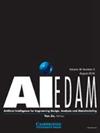Tool life prediction via SMB-enabled monitor based on BPNN coupling algorithms for sustainable manufacturing
IF 2.3
3区 工程技术
Q3 COMPUTER SCIENCE, ARTIFICIAL INTELLIGENCE
Ai Edam-Artificial Intelligence for Engineering Design Analysis and Manufacturing
Pub Date : 2023-07-03
DOI:10.1017/S0890060423000082
引用次数: 0
Abstract
Abstract The predictive methods of tool wear are usually based on different algorithm predictors, different source data, and different sensing devices for remaining useful life (RUL). In general, it has challenges to model and ensure all of the cutting conditions that are suitable in the actual cutting process for sustainable manufacturing. In order to overcome the doing large amount of experimental data and predict different tool RULs, this study combines the analytical force modeling, the back-propagation neural network (BPNN) machine learning, and the current sensor which all are integrated in smart machine box (SMB) to realize the practical RUL prediction for on-line and real-time applications. The analytical model of the cutting force coefficients of shear and ploughing was established from average cutting forces, it could reduce the experimental number and predict the different cutting conditions. In general, the loading current of the cutting tool from a spindle motor is relatively easier acquired than the resultant forces. Thus, the loading currents of the spindle are used to train and predict the cutting forces using the BPNN model during intelligent manufacturing. The SMB architecture mainly performed the autonomous actions based on the edge layer, the fog layer, and the cloud layer via the TCP/IP, the MQTT protocol, and the unified communication library. Results showed that a predictive error for the ends of the tool life is about 3–10% that are based on the calculating of the cumulative current ratio.基于BPNN耦合算法的SMB监视器工具寿命预测用于可持续制造
刀具磨损预测方法通常基于不同的预测算法、不同的源数据和不同的剩余使用寿命(RUL)传感装置。一般来说,建模和确保所有的切削条件都适合于实际的切削过程,以实现可持续制造,这是一个挑战。为了克服做大量实验数据和预测不同工具RUL的问题,本研究将分析力建模、反向传播神经网络(BPNN)机器学习和电流传感器集成在智能机器箱(SMB)中,实现了在线和实时应用的实际RUL预测。从平均切削力出发,建立了剪切和犁耕切削力系数的解析模型,可以减少试验次数,预测不同切削工况。一般来说,从主轴电机获得的切削刀具的加载电流比获得合力相对容易。因此,在智能制造过程中,采用bp神经网络模型,利用主轴的加载电流来训练和预测切削力。SMB体系结构主要通过TCP/IP协议、MQTT协议和统一通信库实现基于边缘层、雾层和云层的自治操作。结果表明,基于累积电流比计算的刀具寿命末端预测误差约为3-10%。
本文章由计算机程序翻译,如有差异,请以英文原文为准。
求助全文
约1分钟内获得全文
求助全文
来源期刊
CiteScore
4.40
自引率
14.30%
发文量
27
审稿时长
>12 weeks
期刊介绍:
The journal publishes original articles about significant AI theory and applications based on the most up-to-date research in all branches and phases of engineering. Suitable topics include: analysis and evaluation; selection; configuration and design; manufacturing and assembly; and concurrent engineering. Specifically, the journal is interested in the use of AI in planning, design, analysis, simulation, qualitative reasoning, spatial reasoning and graphics, manufacturing, assembly, process planning, scheduling, numerical analysis, optimization, distributed systems, multi-agent applications, cooperation, cognitive modeling, learning and creativity. AI EDAM is also interested in original, major applications of state-of-the-art knowledge-based techniques to important engineering problems.

 求助内容:
求助内容: 应助结果提醒方式:
应助结果提醒方式:


